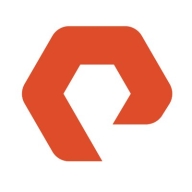

![SwiftStack [EOL] Logo](https://images.peerspot.com/image/upload/c_scale,dpr_3.0,f_auto,q_100,w_64/rCrJ5QMmvucDdhnMyyNUFbAd.jpeg?_a=BACAGSDL)
Find out what your peers are saying about Red Hat, Nutanix, Dell Technologies and others in File and Object Storage.


| Company Size | Count |
|---|---|
| Small Business | 11 |
| Midsize Enterprise | 11 |
| Large Enterprise | 21 |
| Company Size | Count |
|---|---|
| Small Business | 5 |
| Midsize Enterprise | 4 |
| Large Enterprise | 11 |
| Company Size | Count |
|---|---|
| Small Business | 3 |
| Midsize Enterprise | 2 |
| Large Enterprise | 3 |
FlashBlade is the industry’s most advanced scale-out storage for unstructured data, powered by a modern, massively parallel architecture to consolidate complex data silos (like backup appliances and data lakes) and accelerate tomorrow’s discoveries and insights.
Store and manage unstructured data at scale using NetApp StorageGRID for secure, durable object storage. Place content in the right location, at the right time, and on the right storage tier, optimizing workflows and reducing overall costs for globally distributed rich media.
SwiftStack [EOL] offers robust cloud integration, rapid deployment, and hardware-agnostic capabilities, making it a preferred choice for organizations needing scalable and flexible storage solutions. It supports a variety of storage needs from object storage to enterprise-grade backup systems.
SwiftStack [EOL] is recognized for its seamless cloud integration and platform independence, enabling rapid deployment and superior scalability. Its metadata search, proxyFS, and 1space feature enhance versatility and backup efficiency. SwiftStack Controller provides an enhanced management experience with easy system upgrades and performance monitoring. While the management UI and ProxyFS maturity have room for improvement, users seek more organized interfaces and better REST API support. Enhancements in erasure coding configurations and data archiving, along with improved client library integrations, are highlighted needs. The demand for NFS integration improvements and options for data movement between storage policies is noted.
What are the key features of SwiftStack?SwiftStack [EOL] is implemented in industries as a backup platform for Commvault and Veeam, cloud storage similar to Amazon S3 or Azure Blob. It's essential for SaaS platforms, data sharing in research, preproduction object storage, data center operations, and archival management for OpenStack Swift servers in educational and research institutions.
We monitor all File and Object Storage reviews to prevent fraudulent reviews and keep review quality high. We do not post reviews by company employees or direct competitors. We validate each review for authenticity via cross-reference with LinkedIn, and personal follow-up with the reviewer when necessary.